Shadowmania
The year from June 1960 to June 1961 saw the meteoric rise to fame that all young Rock ’n’ Rollers dreamed of, and the tune that launched a thousand red Fender guitars and my own first bout of Shadowmania was, of course, Apache.
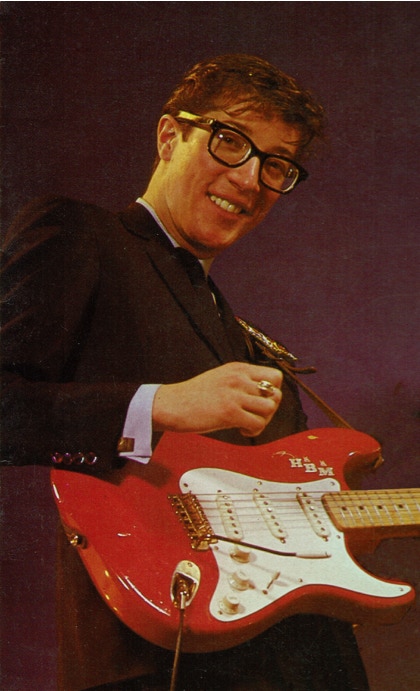
Back from the States, Cliff and The Shadows first heard it in April or May 1960, while they were on a tour that included aspiring singer-songwriter, Jerry Lordan. Even picked out on Jerry’s ukulele, it still seemed a knock-out! The Shadows rehearsed and perfected their rendition in dressing rooms “as far apart as Cardiff, Carlisle and Glasgow”. They knew that the number had already been recorded by a solo guitarist, the solo guitarist of the day, Bert Weedon. When Bert said that he had no intention of making much of it, they pressed ahead and took the tune to Norrie Paramor of EMI, who thought it stood a good chance… as a B side!
This was the Shadows’ third, and, if it had failed, would have been their last crack at the Big Time; but Norrie had always been convinced that it was instrumentals, rather than vocal tracks, that would do it. Recorded on 17th June at EMI Abbey Road Studios, and released in July 1960, Apache entered the charts at No.19, just as Cliff was heading for No.1 with Please Don’t Tease. Until then, The Shadows had been very much, well… in the shadows.
Cliff Richard and The Shadows - Please Don’t Tease
Apache, however, arrived with a very different kind of vibe. It displaced Cliff on August 20th and stayed at No.1 for five weeks. It was Jack Good who made what would now be considered an astonishing politically incorrect promotional film that accompanied it.
I can’t resist watching it again. Look at the hat! Look at the fag-end and the winkle-picker shoes!! Look at those faces!!! As far as we were concerned, this was the Angel Gabriel and friends (who included Buddy Holly, by the looks of things), dressed as James Dean, soooper cool and making magic as they played.
Apache
Apache remained in the charts for an amazing 21 weeks, got The Shadows their first Silver Disc, then a Gold, with more than a million copies sold. It was a hit in in Scandinavia, Europe, South Africa, New Zealand, Australia, India and Hong Kong – just about everywhere you could have a hit, in fact, except in the USA, where a version by a Danish guitarist, Jorgen Ingmann, had the success with it. Apache is often called the all-time instrumental classic, and if you haven’t walked round your bedroom playing it on your cricket bat or tennis racquet, you just haven’t lived.
Author’s Note: Before you decide which instrumental number is, in fact, the best of all time, please first consider Wonderful Land and Atlantis, by The Shadows, and Diamonds, by Jet Harris and Tony Meehan - all of them composed by Jerry Lordan!
Norrie had been right about The Shadows breaking into stardom by playing instrumentals. Just before they released Apache, he suggested that they got someone to handle their affairs, as a separate act from Cliff. He introduced them to an Australian, the unassuming Peter Gormley, who was at that time also managing Frank Ifield. With Peter’s shrewd and honest guidance, an independent career was launched.
At first it was all a bit of a joke that The Shadows had knocked Cliff from the No.1 spot. He was, after all, their boss…. Take a look at this video where Cliff is impersonating Hank!
Apache played by Cliff
In those days, Cliff was being managed by Tito Burns, who had little regard for what he saw as a temporary backing-band. But Cliff himself was always very supportive of The Shadows, regarding them all as a unit, and, indeed, playing the Chinese drum that gave Apache such a unique introduction. Says Bruce: “Even though Cliff was our boss and paid our wages, he was always one of us: it was never a ‘them and me’ situation. We were five lads together, sharing almost everything.” In fact, Hank and Bruce even shared a six-roomed flat with Cliff, rented between them at twelve guineas a week.
In October 1960, following the success of Apache, Cliff released an LP with the title ME AND MY SHADOWS, ensuring that his No.1 backing-band got credit where it was due. By that time, of course, Jet already had a screamy fan-base and fan-mail of his own. Shadows Fans loved some of these tracks, such as the bass-heavy She’s Gone and Choppin’ and Changin’.
She’s Gone
Choppin’ and Changin’
Other newly afflicted Shadowmanics, like me, took to Lamp of Love and Gee Whiz It’s You.
Lamp of Love
Gee Whiz It’s You
We clung to these tracks for dear life until, in November 1960, The Shadows released their next Single, the double-sided hit Man of Mystery/The Stranger.
Man of Mystery
The Stranger
The Shadows were then performing nightly with Cliff in Stars In Their Eyes at the London Palladium. The season ran from June until Christmas, but despite the fact that they were in the No.1 spot a lot of the time, they weren’t allowed to perform Apache on stage because it wasn’t deemed to fit in with the rest of the show. Says Bruce:
“The show starred Russ Conway, Joan Regan, David Kossoff, Edmund Hockridge and Des O’Connor. Hank, Jet, Tony and I were earning £25 a week and although we had a record at No.1 in the charts and were also featured on the record currently at No.2... it was madness. Here we were, the biggest recording artistes in British show business, and we weren’t allowed to feature the country’s best-selling single…”
Prior to this, purely as a backing group on Cliff’s records, they had been, according to Bruce, “on a session fee of £24, split four ways!” But even now, being allowed to perform only with Cliff had its limitations…so on Sundays, to make a bit more out of their success, The Shadows went out on their own. Shadowmania was starting to get a nationwide grip.
The recent TV series The Crown had a scene in which the young Prince Philip is shown doing press-ups to the tune of Man of Mystery. I don’t know whether things went quite that far, but Cliff and The Shadows knew they’d
arrived when in late November Princess Margaret and Antony Armstrong-Jones turned up one night in row G, and were followed a few days later by the Queen Mother at a specially requested Midnight Matinee. At the “Pied Piper’s Charity Ball” held at the Hyde Park Hotel, Cliff and The Shadows were “booked as the cabaret – at Princess Margaret’s request”. She asked Hank how much his guitar weighed and seemed “more like a very well informed fan than Royalty”.
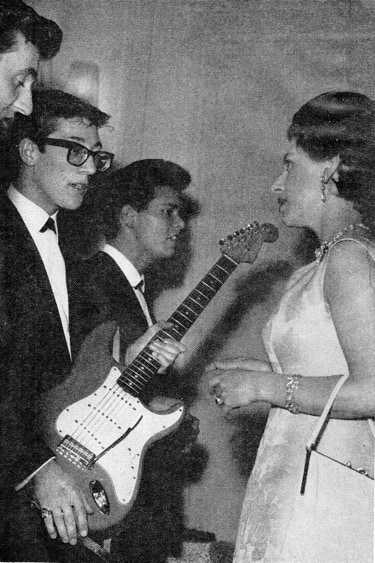
Princess Margaret talking to Hank
Not all Shadows Fans were quite that posh, but Shadowmania was definitely on the rise. Two wildly keen fans from Southend, who wrote to Bruce wherever they played, eventually presented him with a 47,000-word letter that outlined their adventures in following them everywhere. Says Royston Ellis: “Bruce was really moved when he received it. He read it through without being able to put it down. At the end he was left speechless. He choked, deeply affected by the sincerity and enthusiasm of his two admirers.” Hank, meanwhile, got a letter from a student who was writing a book about a local boy making good. He said he wanted to base his main character on Hank!
If you turned on your radio between July 1960 and July 1961, there was a very good chance that you’d hear at least one track featuring The Shadows. For many weeks they were on three Singles in the charts at the same time. Cliff’s next, Nine Times Out of Ten, came into the charts on 22nd September and stayed there for 12 weeks, and I Love You, written by Bruce, was the Christmas No.1.
Nine Times out of Ten
I Love You
In the meantime, Man of Mystery meant The Shadows’ “twang” was in the charts for the rest of the year.
Then in January 1961, came THE SHADOWS EP, with four new tracks. It was No.1 in the newly-established EP charts for 20 weeks (a record only ever beaten by their second UK EP, Shadows To The Fore).
As Malcolm Campbell’s encyclopaedic A Pocket Guide to Shadow Music points out, the EP was “simply a must-have”, thrilling Shadows Fans, with “a refreshingly raw and spontaneous feel to it”. Two of the tracks were well-known film themes, one from Shane, starring Alan Ladd in 1953, and the other from Giant, which had been James Dean’s last movie in 1956. A third track, Mustang, was co-written by Jerry Lordan and Thomas Mould; and Shotgun, so it emerged much later, was composed by Hank, Bruce and Jet, but originally published under the pseudonym “Jon Allen”.
Shotgun
Mustang
Theme from Giant
Theme from Shane
Never mind the tunes, I say, look at the cover! I well remember the day I bought this precious EP which was, I’m pretty sure, on the day it was released. I got as far as the doorway of Landau’s record shop in Sutton High Street, took my purchase out of the bag and just stood there for several minutes, devouring it with my gaze, before I could face putting it back in the wrapping and getting the bus home to listen to it. Here, in all its glory, is the very item I now had in my hand…
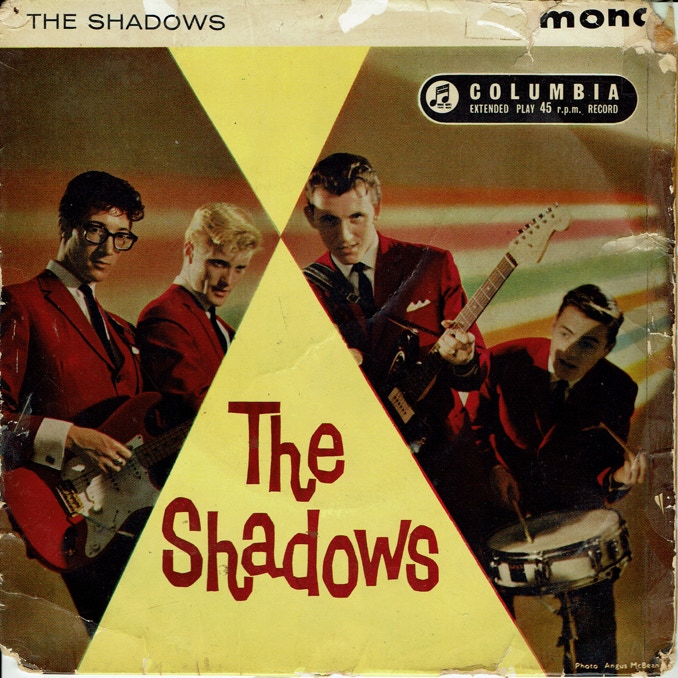
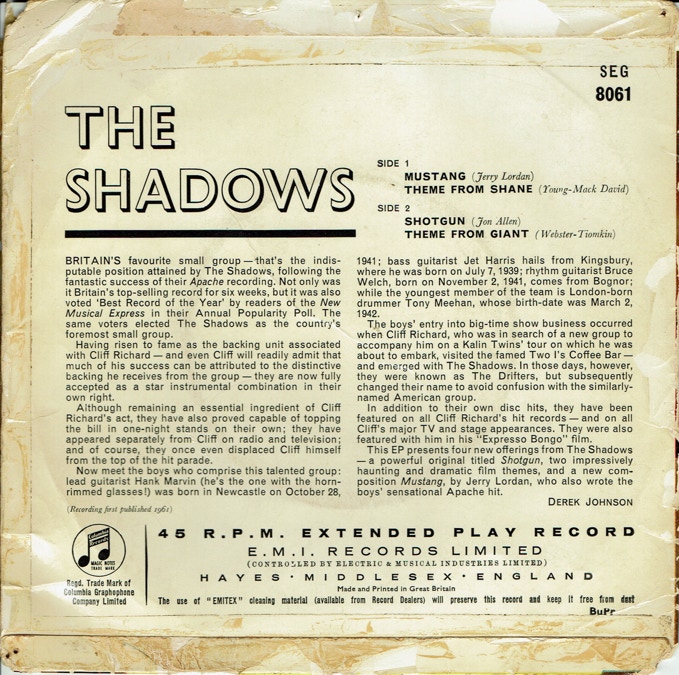
The EP sleeve-notes aren’t entirely accurate: Shadowmaniacs will notice that they give Tony’s birth year as 1942, instead of ’43. (When they were composed, he must still have been fibbing about his age in order to be able to work the hours he did with Cliff!) But if you could wear a picture out by looking at it, this would certainly have been the case. Note the marks showing that it was later pinned on the bedroom wall.
I sailed into my teens bopping round the kitchen with the EP cover parked on the top of the fridge and the publicity photo for the next Single propped up next to my homework on the table.

Publicity shot for FBI
The amazing and wonderful FBI was released at the beginning of February 1961 and made it into the charts in time for Valentine’s Day. I can assure you that by this time things had begun to get very serious, as far as I was concerned.
FBI
It wasn’t just me! As well as their Rocker fans from the early days, the ones with the leather jackets and the Rock ’n’ Roll shoes, The Shadows were now acquiring an audience of younger kids, who saw them on children’s TV programmes such a Crackerjack.
“Not so long ago,” said one of The Shadows in 1961 in The Shadows by Themselves, “an expert on Children’s Musical Interests told a conference that ‘Cliff Richard and his group, The Shadows, have done more to continue the musical education of some children than the whole world of music teachers and administrators.’”
It might surprise them to know that they also contributed to the classical education of young ladies in the leafy suburbs of London. One sleepy afternoon our bouncy young Latin teacher bounced into class and woke us all up by writing just one word on the blackboard:
“Hanc”
“No, Miss! It’s spelt with a ‘k’!” we chorused. Apparently “hanc” is one of the ways to say “this” in Latin. Or it might even be “that”. Don’t ask me; but I can still recite the variations now: hic, haec, hoc, hunc, hanc, hoc. It seemed to say it in a nutshell.
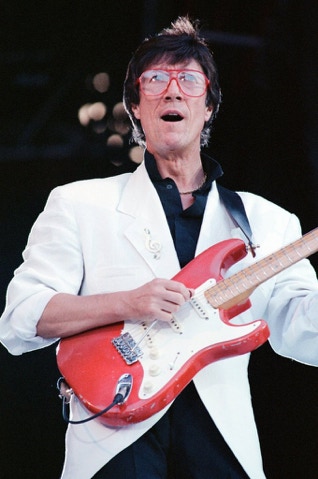
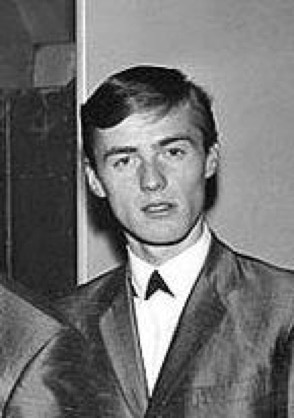
The inspiration for my rough-book sketch
“Never mind the Biology of the flipping rabbit, girls, let’s get on with the practical!” That’s what we said, as we dived under our desk-lids for our pin-ups stuck on the underside. Even more useful than that during lessons, I later found, was flipping through my school rough-book, the back inside cover of which I had adorned with my beautiful, hand-drawn, pencil portrait of Tony’s simply adorable countenance!
With FBI about to hit the charts, Cliff and The Shadows completed another nationwide tour of relentless, consecutive one-nighters:
February 1961
05 - Birmingham (Hippodrome)
06 - Derby (Gaumont)
07 - Stockton (Globe)
08 - Glasgow (Green’s Playhouse)
09 - Edinburgh (Usher Hall)
10 - Newcastle (City Hall)
11 - Sheffield (City Hall)
12 - Liverpool (Empire)
13 - Leicester (De Montfort Hall)
14 - Bristol (Colston Hall)
15 - Cardiff (Gaumont)
16 - Southampton (Gaumont)
17 - Southend (Odeon)
18 - Lewisham (Gaumont)
19 - Ipswich (Gaumont)
20 - Portsmouth (Guildhall)
21 - Wolverhampton (Gaumont)
22 - Doncaster (Gaumont)
23 - Chester (Gaumont)
24 - York (Rialto)
25 - Bradford (Gaumont)
26 - Worcester (Gaumont)
Less than a week later, on 2nd March 1961 – the occasion of Tony’s 18th birthday, as it happened − they embarked on a tour of South Africa and Rhodesia (later Zimbabwe) and Singapore.
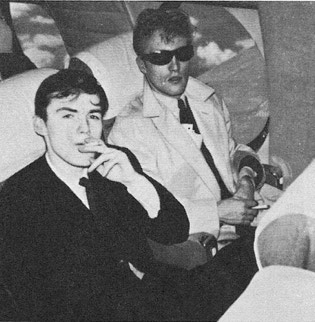
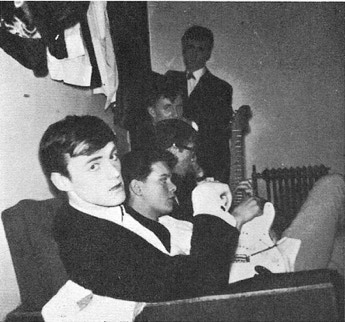
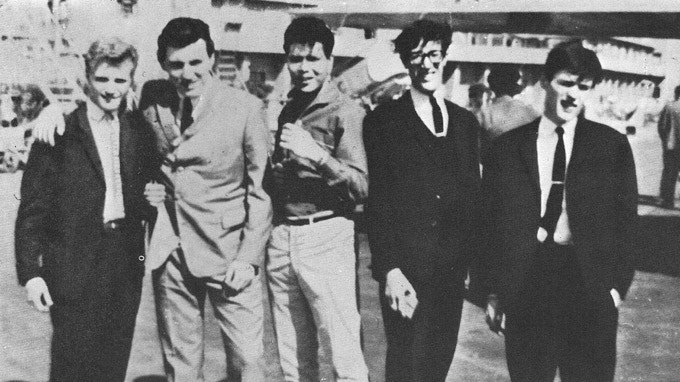
An account of the South African tour was published later in 1961 by the Daily Mirror, as part of Cliff’s book, Me and My Shadows, in which he introduced the public to “four friends of mine who have − I am glad to say − become stars in their own right”. Did I buy it? Have a guess!
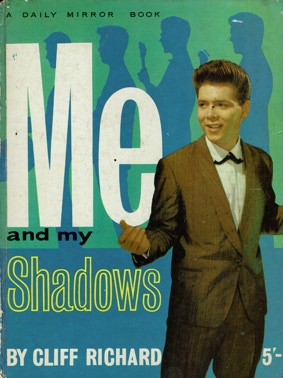
Cliff’s book. Good title, huh?
In March 1961, Cliff and The Shadows flew first to Bulawayo, where 6000 fans were waiting for them to arrive. The tour continued to Johannesburg, Durban and Port Elizabeth, returning to Salisbury. Again the response from the fans was overwhelming. Royston Ellis quotes them as saying:
“At Johannesburg there were two or three thousand people waiting at the airport. Cliff got into a big red Lincoln Convertible, and we clambered into a Chevrolet. It was just like something you see on the films! A large police motor cycle escort roared along the road beside us. For six miles there were crowds lining the road all the way into town. Banners and signs were hanging from overhead bridges and the crowds were cheering and waving. We felt just like royalty… We went to South Africa as a backing group, and then back as ‘stars’!”
By the time they left the country, the South African Top Ten contained no less than 8 tracks with or by the Shadows:
1. Theme for a Dream
2. Surrender (Elvis)
3. FBI
4. Man of Mystery
5. I Love You
6. Evergreen Tree
7. Gee Whiz It’s You
8. Shazam
9. Walk Right Back (Everly Brothers)
10. Temptation
In Johannesburg, says Bruce, “We have never had a reception like it anywhere in the world before or since… thousands upon thousands of people, screaming, cheering, crying, chanting, came out to meet us. They lined the route into the city centre, hung out of the windows of tall buildings and climbed up lamp-posts for a better view. It was an absolutely unbelievable sight. Cliffmania.”
Stardom brought the shock of virtual imprisonment in their hotel. Cliff tells the story:
“Eventually, by about nine o’clock in the morning, the hotel was completely surrounded. It was getting very hot and Bruce, Hank, Jet and Tony, to say nothing of me, were anxious to go off for a swim, We were able to make a bargain with a reporter from the Johannesburg newspaper. We would give him an interview, if he would smuggle us out of the hotel… Eventually, he got us out and into one of his paper’s staff cars. I wanted to stop at a camera shop, but within seconds the news had got around and hundreds of girls came streaming down the street towards us. We made a quick dash back to the hotel and I spent the morning and afternoon sun-bathing on the roof. That was the only place left to go.”
This photograph shows the kind of thing they were looking at in the street outside their hotel; but while in South Africa, they also had their first uncomfortable encounter with apartheid. Notice the policed gap, with black fans allowed at the back.
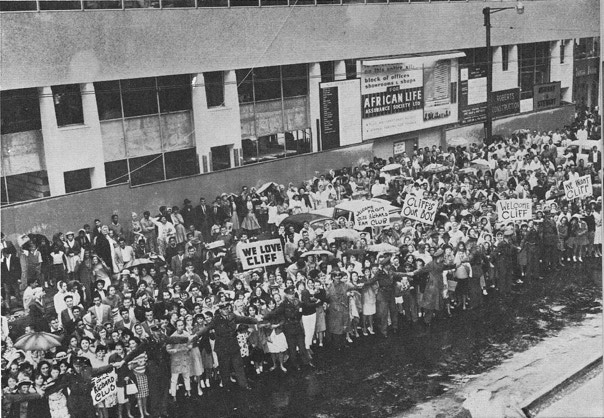
Bruce writes: “We overcame it by purposely putting on a series of extra shows for the benefit of the coloured South Africans in the townships outside the cities. The audience reaction was tremendous. We appeared in one of the shanty towns outside Johannesburg, where the living conditions of the inhabitants were horrific.”


If The Shadows hadn’t had stars in their eyes before they left England, they did now! They had their own spot in the show, closing the first half, with a performance that has been immortalised on the The Shadows at the Colosseum Johannesburg EP. Below is a photo of my own somewhat worn copy of what later became a much sought-after item. No doubt purists will note that some of the YouTube videos show later additions to the line-up…
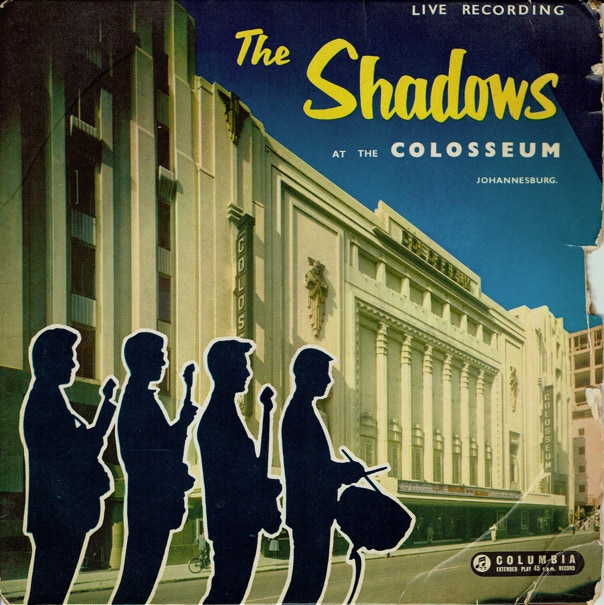
Guitar Boogie Live
Shazam Live
Sleepwalk Live
FBI Live
This priceless gem of a record was originally released only in South Africa, but it became the absolute pride of my collection, having been acquired for me by a South African friend who went home for the school summer holidays. Thank you so very much, Vivienne McCarthy of Sutton!
Immeasurable thanks for my golden memories of these days are also due to the aforementioned beat poet, biographer, and travel writer, Royston Ellis, who co-wrote with The Shadows the book that has been the source of so much material here. This rare bit of footage shows The Shadows, possibly while they were still called The Drifters, backing Royston on stage in 1959.
The Shadows/Drifters and Royston Ellis
Sad to say, The Shadows by Themselves is no longer in print and can rarely be bought second-hand. However, most of the details, together with the original photographs and more, have been included in Royston Ellis’s more recent publication: Cliff Richard and The Shadows – A Rock ’n’ Roll Memoir, with Foreword by Sir Cliff Richard, Tomahawk Press, 2014, still available to purchase online at amazon.co.uk.
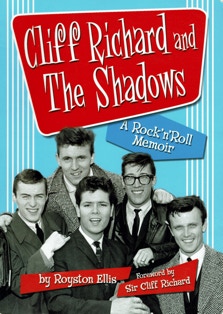
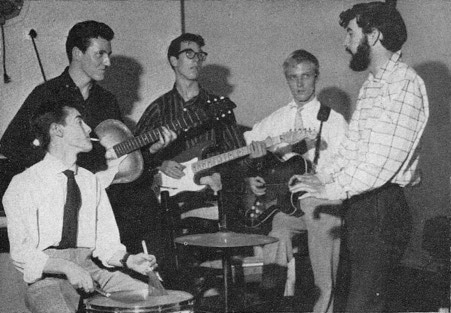
Rehearsing with our friend Royston Ellis for one of his poetry-with-music TV appearances
Below is a shot of my very own copy of what became the Shadowmaniac’s Bible. And here I must also pay grateful tribute to Susan Allison, another class-mate, who gave me The Shadows by Themselves for Christmas! Thanks, Sue! First impressions count, and oh, dear me! This wholly unexpected Christmas gift really does have a lot to answer for!
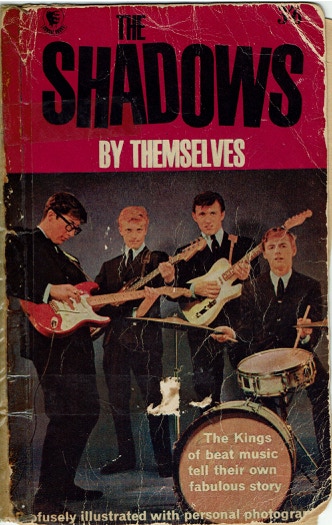
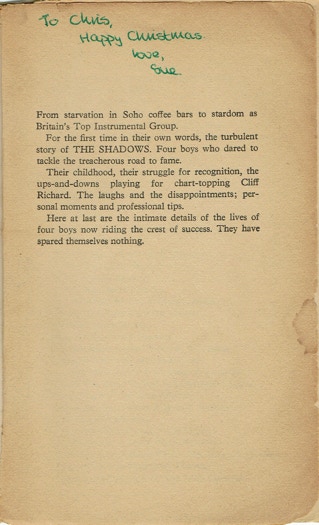
Cliff’s Theme for a Dream had followed the success of FBI. Gee Whiz It’s You went into the charts in June and it was followed by A Girl Like You, also in June.
Theme for a Dream
A Girl Like You
By the summer of 1961 The Shadows were everywhere. Even Latin teachers and Mums and Dads had heard of them. My own Shadowmania was running high and now it really was time that I got round to seeing them on stage, too.
Again, I think Chuck Berry had the mood just about right here, except that I was Sweet Little Thirteen at the time! This classic from1959 might have been written just for me!
Chuck Berry - Sweet Little Sixteen
Cookies:
Copyright:
This web site doesn’t save any cookies or any personal data.
Google, however, will track which YouTube videos are played.
If you own the copyright to any content here and wish to receive credit or have it removed, please contact me and I will respond promptly.

